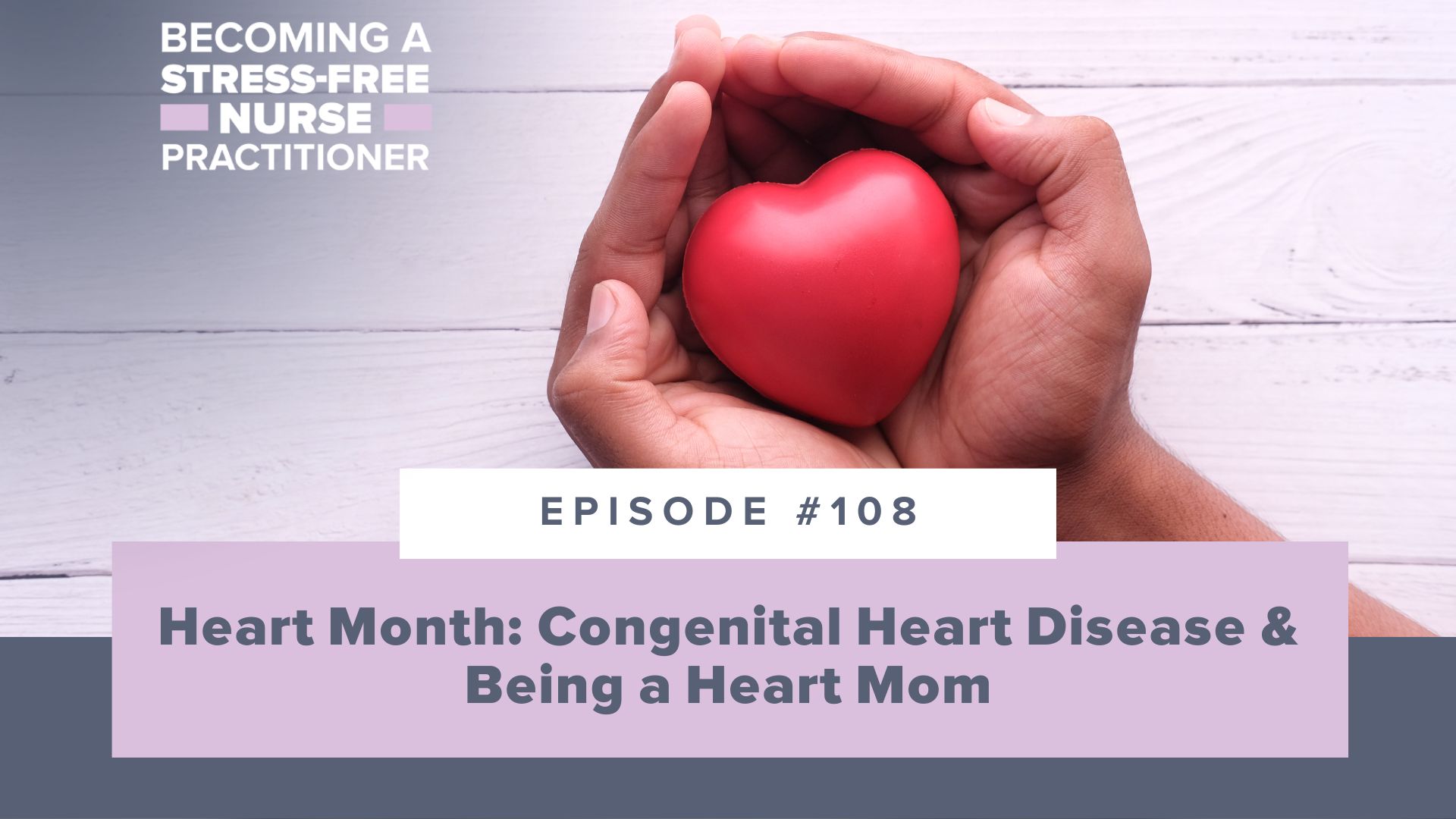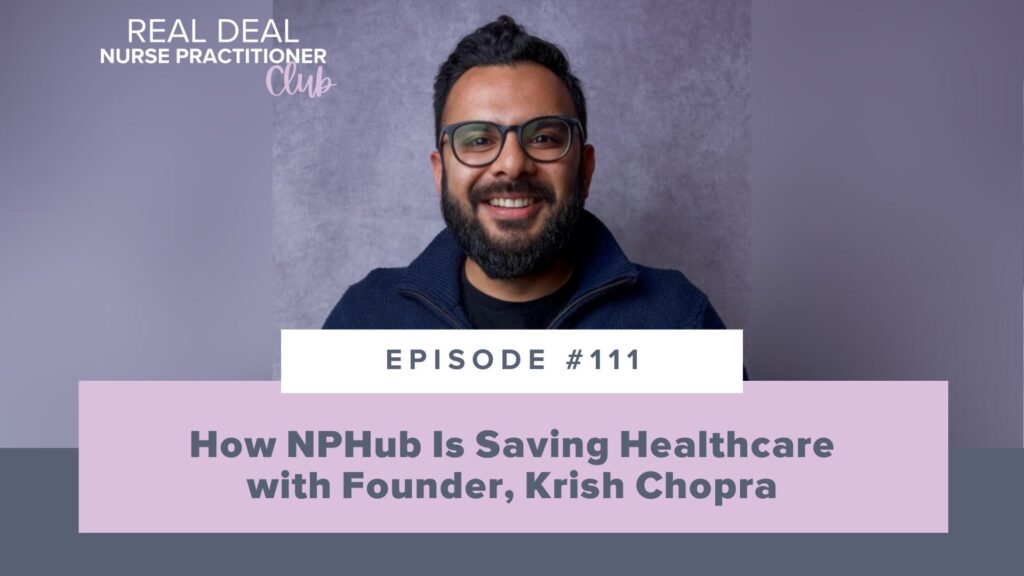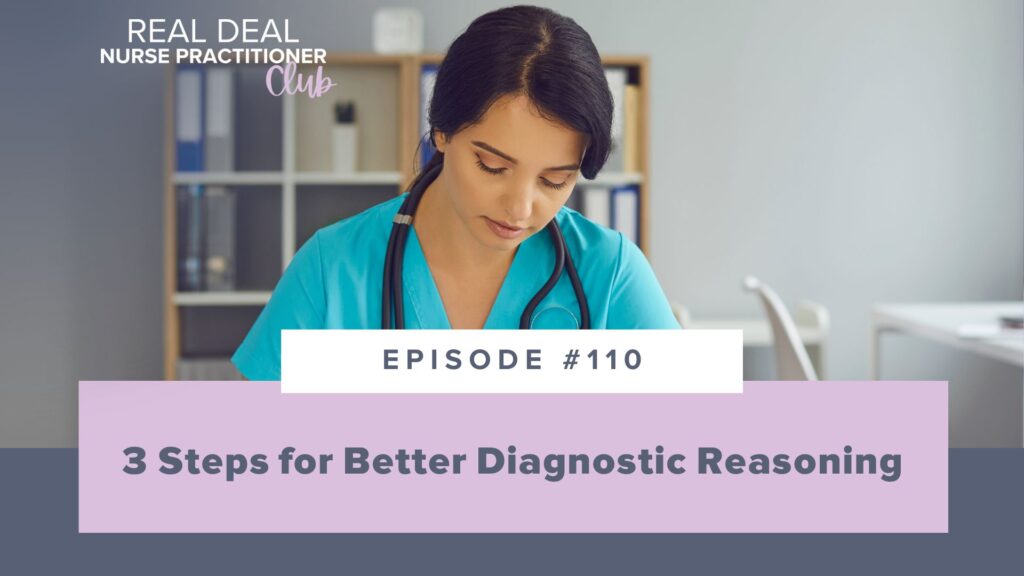Ep #108: Heart Month: Congenital Heart Disease & Being a Heart Mom
- by Sarah Michelle
- Mar 06, 2024
- Podcasts

I know this podcast is where we talk about all things related to being a Nurse Practitioner and study tips, but I hope you’ll oblige me this week as I touch on something deeply important to me: Heart Month.
For those of you who aren’t familiar, my daughter Meadow was born with a severe congenital heart defect last year. Being an advocate for congenital heart disease feels like the most special and important thing I can do as a Heart Mom, and sharing more about this is exactly what I felt called to do this Heart Month.
Join me this week as I share some statistics on congenital heart disease that may shock you, and why I’m so invested in giving Heart Babies the very best chance we possibly can. You’ll hear what my daughter’s life will look like living with a congenital heart defect, and a poem I wrote about my experience as a Heart Mom.
If you’re looking for support, no matter what phase of your nurse practitioner journey you’re currently in, I have communities available for both students and new nurse practitioners. In these communities, we work to uplift one another and grow this profession together every day. Interested? Click here if you’re a student and click here if you’re a new NP!
What You Will Discover:
- Why I’m deeply invested in Heart Month.
- The statistics on congenital heart disease that may shock you.
- More on my daughter’s congenital heart defect.
- A poem that encapsulates my experience as a Heart Mom to a Heart Baby.
Featured on the Show
Full Episode Transcript:

Welcome to Becoming a Stress-Free Nurse Practitioner, a show for new NPs and students that want to pass their board exam the first time and make that transition from RN to NP as seamless as possible. I’m your host Sarah Michelle. Now, let’s dive into today’s episode.
Hello, my friend. If you’re listening to this episode right now, it is just Sarah Michelle here and I sat down at my office desk this morning and I was preparing to look at a couple different podcasts we were thinking about doing and I’ve got some course recordings to do, all this good stuff. But instead I decided, I just felt a notion or I felt really called, called sounds cliché, but I felt really called to do a heart month podcast.
I did a heart month podcast last year, it was really tough for me to go to, but it was really important for me to do because Meadow had just gotten out of the hospital, that’s my daughter for those of you who don’t know, about a month before heart month. And month spans for all of February, but from February 7th to 14th that’s really CHD awareness week. But I really make all of heart month CHD awareness month.
And so for those of you who are unfamiliar, my daughter was unexpectedly born with a severe congenital heart defect. And the statistics on severe congenital heart defects is that about 25% of those children are not going to make it to their first birthday.
And it was really scary to find out at the very end of my pregnancy, and when I say the end, like I found out at 36 weeks, I gave birth at 39 weeks. But being an advocate for congenital heart disease feels like the most special and most important thing I could ever do. So I hope you will give me some grace and leniency as I put out this episode.
I know that we talk all about being a new nurse practitioner, being a student and studying tips. All of that stuff is super important as well, but I also find it super important to share about congenital heart disease because there’s a statistic that I bet a lot of you are going to be shocked by, not if you follow me on Instagram though because I’ve talked about this a lot on Instagram.
But congenital heart disease, this is crazy you guys, congenital heart disease is 60 times more prevalent than childhood cancer, but only receives one fifth of the funding. And what we have to realize about congenital heart disease is that for most of these children there is no cure. There is no one stop fix, like you’re done, your heart is fixed, see you later.
I remember it being really, really hard to digest right before Meadow had her full repair. And you hear the words full repair and you’re like, okay, she’s fixed, but literally on the surgery document it talked about it being palliative care because Meadow and the heart defect she has, which I’m going to jump into in a minute, her heart defect, she’s going to continue to have surgeries throughout the rest of her lifetime.
And so more research, more funding, more awareness is super important, not only for the life of Meadow, but all the other heart babies around her. And so I really just want to just use this episode kind of as a rallying cry, if you’ll let me do that, because obviously this cause means the world to me and my heart is deeply invested in it.
So that being said, for those of you that need a little bit of back story, I have a highlight on Instagram that talks about Meadow’s entire journey throughout her initial surgery, her interstage time as they call it, and then her full repair was a lot. But to take it back a little bit, she has something called Tetralogy of Fallot.
Tetralogy of Fallot itself is the most common cyanotic heart defect there is. And just in general, to throw another statistic at you that is crazy, 1 in 100 babies will be born with some type of heart defect. Now, it doesn’t have to be a severe one, like Meadow had, but 1 in 100 babies. That means likely someone you know, or maybe even you yourself, will have a baby with congenital heart disease in your lifetime.
And so with Meadow in particular, she had to be special, she’s always been special. But she had to be a little extra special because she has Tetralogy of Fallot with pulmonary atresia. I like to tell people that Meadow is my little four leaf clover because the odds of having Tetralogy of Fallot with pulmonary atresia simultaneously is 1 in 10,000, which are by the way the odds of finding a four leaf clover.
And so with Tetralogy of Fallot, it comes with separate defects. The first one is the ventricular septal defect. So what that means is that there is a hole in the septum between those two ventricles. She had a very large ventricular septal defect.
She also had an overriding aorta. That’s the second part of this. And with an overriding aorta that means that the aorta is shifted a little bit out of place, it’s actually sitting directly on top of that BSD. Alongside this we see right ventricular hypertrophy, because that right ventricle is having to work really hard against what is typically pulmonary stenosis. So that pulmonary valve is very stenotic, it’s hard to push the blood through to the lungs.
Like I said, Meadow is special, so Meadow did not have pulmonary stenosis, she had pulmonary atresia where essentially the blood could not flow from her right ventricle to her lungs because it was completely closed off. It was not stenotic, it was completely closed off, which is just so scary to even think about the fact that I birthed a baby that did not have a pulmonary valve essentially, just whoa, break your brain.
With all that being said, her first surgery was when she was only seven days old. I mean just fresh as a fresh new baby. I could not believe that I was giving my baby away to have her chest opened. And I remember thinking of it, and the way I often describe it is as a patch.
And so the first surgery that Meadow had is the BTT shunt. You may hear it referred to sometimes as the BT shunt, you should Google why BTT shunt is very important. It’s a super important part of heart history because the first successful open heart surgery was actually this BTT shunt, and this is what allowed Tetralogy of Fallot babies, which have historically been nicknamed the blue babies, a chance at life, a chance at survival, a chance to figure this out for them.
I’ve done a lot of research into Tetralogy of Fallot with pulmonary atresia because the first surgery that happened about 70 years ago now was this BTT shunt to buy time. And then the second surgery was figuring out, okay, how do we fully repair this and let these babies and children go on to living fuller lives?
You know, just 70 years ago only 20% of children with a severe congenital heart defect made it to be an adult, so made it to be 18 years old. That number has now changed to 60%, which I could just cry thinking about. But that being said, she had her first surgery and then we had something called interstage time.
So interstage time, we were part of a single ventricle program because they considered Meadow single ventricle because she did not have that pulmonary valve from having pulmonary atresia. And we took a baby home to hopefully grow and thrive and learn how to eat and do all the normal baby things and gain enough weight to be at a point where it would be safest for her to have her full repair.
Now here’s what you have to think about in this interstage time, and this is why it’s so high risk. Her BTT shunt was the size of basically a diamond stud earring. So super teeny tiny, right? And that was the only thing getting blood to her lungs. And so if you think about it, that in itself breaks my brain because if it were to clot off, which was always the major risk, I mean she’s not getting any blood flow.
So every day we had to be hyper vigilant and watching. Is it possibly clotting off today? Is it possibly clotting off today? We had to submit her oxygen readings twice a day to her cardiology team. We had to submit her weight every single day to her cardiology team. There was always somebody watching her. And it was a very intense time in our lives because with the way the BTT shunt works, her oxygen ran 75 to 85% and that was her normal.
And it was so scary to take home a baby at the end of August. She was born on August 3rd, we got to take her home for the first time at the end of August, and just know that she was always going to look a little blue and a little purple. And just know that her oxygen was 75 to 85%. And it was so scary.
But that being said, her shunt held up all the way to Thanksgiving, and very luckily we did not go to Thanksgiving that year. We thought it was too much of a risk to Meadow’s health. We were very worried about Covid, flu, RSV, you name it because if she were to get sick and her shunt goes bad, there might be delays in her surgery. It was a little bit of chaos, so we just didn’t want to take that risk.
And that weekend, right after Black Friday, I was sitting up with Meadow early, early in the morning and her oxygen dropped down in the 50s. And I was like, oh, this is a fluke, I’m going to get my other monitor, because me being me, I had two oxygen monitors. Even though they would only give us one, I bought a second one. And I checked it again and it was in the 60s at that point, but it popped back up. But the weird part was a lot of times when we got skewed readings, she was moving her foot, but Meadow was dead asleep.
So Monday we go in and we find out that her shunt is indeed a little bit more stenotic than it was before. It was about half the size of what it should have been. And so now we have to unexpectedly have her second surgery faster.
And I cannot tell you the grief I still live with and the grief I’m still working through today that we spent all of Meadow’s first holidays in the hospital, you know. She was our first baby, we were first time parents, we wanted all of those special moments with her. And we felt like we had lost so many of them already just in the chaos of her birth, her having her first heart surgery at seven days old, this interstage time where I felt more like her nurse practitioner than actually her mom. And then to have the holidays ripped from us too was really hard.
So everything that we had read online said you’ll be in and out in two weeks from this surgery, like at the most. At the very, very most. And like I said, Meadow being Meadow, we were not in and out in two weeks. We were in the ICU for almost two months with Meadow and everything that could have possibly gone wrong, went wrong it felt like. And the night of her surgery, she ended up with a cardiac tamponade and almost died in front of us.
So that being said, I am so passionate and so invigorated and so deeply, deeply invested in heart month. I know that if you follow me on Instagram you might be a little sick of it by now. I promise, after February it will calm down, at least a little bit.
But it is so important that we give all of these heart babies the very best chance that we possibly can at life. And like I already said, the numbers are much better than they’ve ever been. The fact that 20% of severe congenital heart defect babies used to make it to adulthood, now it’s 69%, like I said, that’s amazing, that’s phenomenal. But how can we drive that number higher, right?
There is no cure for congenital heart disease. I think if you get nothing else from this podcast episode, there is no cure, there is so much more work to do. And Meadow is going to have more surgeries in her lifetime. Literally a lifetime full of valve replacements and having her chest opened again and again and again.
And there has been some really cool research into how we can do valve replacements differently And what does this look like in the future? But to be able to come to these new conclusions and find new ways to do things, the first step is awareness.
The second step is getting the funding to then do the research, which is why in May of this year I will be going to Washington DC with my husband and Meadow and we will be advocating to congress about congenital heart disease and how it deserves more funding.
So all of that being said, I would like to leave you with a poem that I wrote about being a heart mom. It’s really short, but I just think it fully encapsulates everything I feel about being a heart mom, having a heart baby who is the truest of truest heart warriors and I just really want to share it with you. So, this is how I’ll end it.
What does it mean to be a heart mom? As if I could even boil it down to simple words. Some days it feels like my entire identity, and other days just a part or a blur. When you’re a heart mom it’s easy to get lost in all the commotion, but there’s a constant striving to get back to one single notion. You are my baby and I am your mom, forever entwined, your imperfect heart and all.
Being a heart mom means you must learn a new language overnight because you are the fierce protector of your baby’s fight. A duality between grief and love so rarely understood, but here’s the thing if you possibly could.
There’s a secret to being a heart mom that you can’t see upfront, you get beautiful extras too. Every inch stone, every accomplishment, every achievement that you may not be able to do makes me so much more grateful to be a mom to you. So while it is scary and oftentimes tough, I would never trade being a heart mom and all this extra abundance of love.
Your heart may be being made and hidden under a tight zipper scar, but may each day we remember that that scar makes you who you are. Alive and whole, broken but fixed, but when you’re in my arms, not a thing is amiss. You are my heart baby and I am your heart mom.
Thanks for obliging me this week to do a heart month podcast, and I’m sure I’ll be talking to you all soon.
As an extra bonus, friends, if you’re looking for support no matter what phase of your nurse practitioner journey you’re currently in, I have communities available for both students and new nurse practitioners. In these communities, we work to uplift one another and grow this profession together every single day. Links to join will be included for you in the show notes.
Thanks for listening to Becoming a Stress-Free Nurse Practitioner. If you want more information about the different types of support we offer to students and new NPs, visit npreviews.com/resources. See you next week.
Enjoy the Show?
- Don’t miss an episode: follow the podcast on Spotify, Apple Podcasts, Google Podcasts, or RSS.
Related Posts
Search the Blog
Join our Facebook Group!
Get FREE support and encouragement from thousands of NP students and our NP Support team.
Learn More3 Study Hacks to Conquer Your NP Exam!
Download these tips that have helped thousands of students pass their NP board exams.
Download NowInstitutional Partnerships
Are you a faculty member and would like to bring Sarah Michelle’s resources to your school? Email us at nursinggroups@blueprintprep.com for special institutional pricing or click on the link below to learn more.
Learn MoreGroup Discounts
Are you a student and have 10 or more classmates interested in purchasing Sarah Michelle’s courses? Email us at nursinggroups@blueprintprep.com for special pricing.



